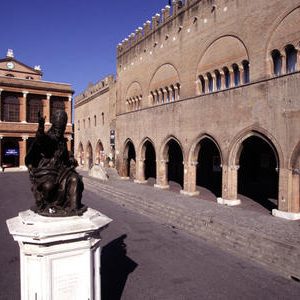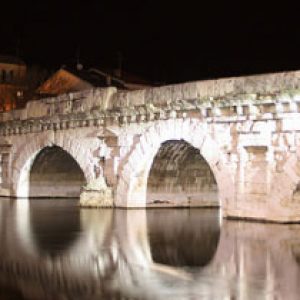What to see in Rimini
Tempio Malatestiano.
This mausoleum temple is located in the heart of the historic center of Rimini, where it is very common to start exploring the city. This temple is a very striking example of Franciscan Gothic of the XIII century, designed by L. Battista Alberti (1404-1472). Almost all masterpieces of this master are considered to be of great value in European architecture. In terms of Renaissance genius, Alberti is on a par with Da Vinci himself.

Today in the Tempio Malatestiano you will see the work “Crucifixion” by the famous painter Giotto executed in 1312 and the fresco by Piero della Francesca, which depicts Sigismondo Malatesta kneeling before his patron saint Sigismondo.
Piazza Cavour (Piazza Cavour)
In the cultural center of Rimini is Piazza Cavour. On this square are located the front sides of three palaces XIII-XVI centuries, the statue of Paul V with his hand raised for blessing, a magnificent fountain “Shishka” XVI century made of white marble, which once delighted Leonardo da Vinci.

The first palace in Piazza Cavour – called Garampi (it now houses the municipality). The second palace is Palazzo del Arengo, built in the early 13th century when Modio de Carbonese ruled. It has always symbolized the liberation of the commune city.
The third palace is Palazzo del Podesta, built in the 1330s.
Another building, the Teatro Comunale, is also located in this square. It opened in 1857. The opening of the theater featured Giuseppe Verdi’s opera Harold.
In the center of Piazza Cavour is the monument to Pope Paul V, erected back in the early 17th century. Next to it is the famous fountain “Conesca” built in 1543 by Giovanni da Carrara. The fountain is made in the form of a circle with three ledges, the upper one symbolizing the Roman era, decorated with a white marble cone. The water that pours from the fountain is always fresh and drinkable.
Arch of Augusta (Arco D'Augusto)
The Arch in honor of Emperor Augustus is the most famous monument of the city. Very famous among tourists as it is the oldest arch in the country. The arch was built in 27 BC. after the Rome and Adriatic road was completed.

The arch was decorated with a two-wheeled chariot, a four-horse chariot, driven by the Emperor Caesar Octavian Augustus.
In the Middle Ages, the Arch served as the entrance to the city from the south side. In those same times, they decided to replace the chariot with a crenelated top. On the front of the Arch are four medallions depicting Zeus, Apollo, Neptune and Minerva.
Bridge of Tiberius (Ponte di Tiberio)
The construction of the Tiberius Bridge was begun in 14-21 AD, during the reign of Emperor Augustus, and completed during the reign of Emperor Tiberius. The bridge is constructed of five arches, over the Marecchia River.

It was almost entirely destroyed in 580, but under the reign of Pope Innocent XI, in 1680, it was rebuilt.
Castel Sigismondo (Castel Sigismondo)
Castel Sigismondo, second name Fortress of Malatesta (Rocca Malatestiana). This castle appeared in the city during the reign of Sigismondo Malatesta in 1430-1446 and was the residence of the ruler.

Sighismondo himself participated in laying the foundations of the castle, as the inscriptions above the main entrance attest.
Palazzo Brioli and Clock Tower
Palazzo Brioli is located in Piazza Tre Martiri, where Julius Caesar himself gave a speech. Only a few columns in front of the entrance to the building and a statue of Caesar remind us of the Roman forum nowadays. The square was named in the last century, in honor of three partisans tortured during World War II.
Rubicone River
The Rubicon River in Rimini is very legendary. Its length is only 29 kilometers and it flows in the north of the city.
It is legendary for Caesar’s campaign. The emperor’s army moved on Rome from the first Roman forum (Piazza Tre Martiri) and crossed the Rubicon River. The winged phrase “crossing the Rubicon” was the impetus for a confident attack and carried the meaning of achieving a big goal.

